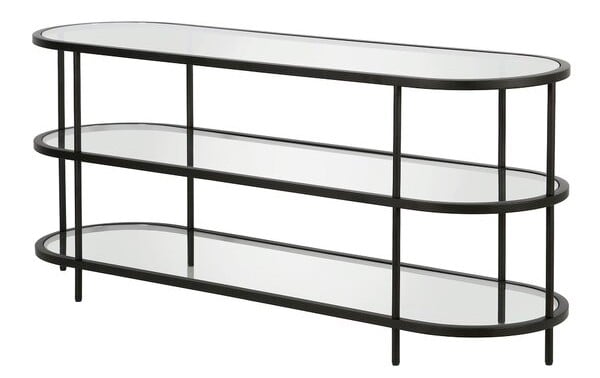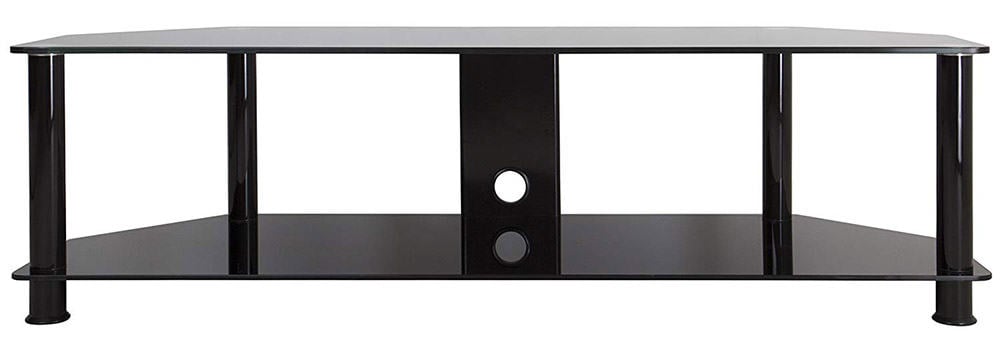Glass flat panel TV stands are one of a number of different choices you have when choosing somewhere to store your home cinema system.
However, it can be difficult to decide which is the best type for you to use.
In my introduction to flat-screen TV stands and furniture, I discuss the different types you will come across and look at the pros and cons of each type.
Once you understand the issues involved, it will make it easier for you to choose the right style and model for your room.
On this page, I look at glass TV stands. Go to the main introduction for details of other types.
Introduction to Glass TV Stands
Glass TV stands have always been a popular choice for holding your TV and storing AV equipment.
Some things never seem to go out of fashion, and the humble glass stand is one of those.
It is a versatile choice for all manner of situations.
If you need a compact design for the corner or a monster unit for housing all manner of AV gear, you will be able to find a stand with glass shelves that fits the bill.
With modern designs and colored glass, it is sometimes not even obvious if glass is used at all.
Let’s take a look at some of the important features of a modern glass TV stand.
1. Different Types
Most glass TV stands combine clear or black glass shelves with either black, silver or chrome supports. Some models have wooden supports.
Higher-quality glass TV stands can feature brushed aluminum or black nickel supports.
If you search online, a far greater variety of finish options exist, including white glass, red glass and grey glass shelves. Some manufacturers offer a wide choice of support finishes like metallic gold, for instance.
Generally, the more specific and unusual the finish choice, the higher the price will be.

Image Credit: AVF
Black glass is currently a popular choice of finish for TV stands – like the AVF SDC1140CMBB-A Media TV Stand pictured above.
The advantage of black glass is that it matches most modern TV finishes in addition to helping to conceal wiring.
However, the downside is that it attracts and shows dust far more than a clear glass alternative.
2. Shelf Thickness
In order to determine the quality of a particular glass TV stand, a number of factors should be considered. Firstly, the thickness of the glass.
Even at the lowest of price points, it is possible to purchase a glass TV stand with an 8mm glass top. However, there is some lower quality glass flat panel TV stands on the market with just 6mm glass top shelves.
I would recommend against these as it is possible to purchase a TV stand with 8mm glass for the same price.
Higher quality glass TV stands feature 10mm, 12mm or even 19mm glass shelves.
The thicker glass increases the strength of the glass TV stand and also helps to reduce unwanted vibrations, which can lower the quality of both audio and video equipment.
Also, always buy a glass TV stand with tempered safety glass. I would always steer clear of any kind of glass furniture which does not feature toughened glass shelves.

Image Credit: Gold Flamingo
The Gold Flamingo Niko glass TV stand, pictured above, has three shelves made from tempered glass.
The structure is reinforced with a steel frame that has a handcrafted finish.
As you can see, the design allows for plenty of space for installing your equipment and for cable management.
Speaking of which…
3. Cable Management
Most types of glass TV stands feature cable management.
Always check this is included with the TV stand before purchasing, as some manufacturers offer it as an optional extra rather than an inclusive feature.
Cable management is critical on clear glass flat panel TV stands because, without cable management, the aesthetics of the TV system will be ruined by unsightly wiring.
Always check the cable management is of sufficient size to accommodate all of your wiring.
Be aware that cable management can simply consist of a panel that enables cables to feed through or a circular column where the cables are physically held inside.
The former method will leave cables hanging out of the back of the TV stand.
The latter covers the cables from all angles but the volume of cables that can be managed is limited to the circumference of the cable management column.

Image Credit: AVF
Also, remember to consider that cable management may eat into the usable shelf depth of the glass TV stand.
Before purchasing a TV stand it is crucial to measure all of the usable shelf space of the stand and compare that to the dimensions of the equipment.
There is nothing worse than constructing a new piece of furniture only to discover it is completely unsuitable for the exact purpose it has been purchased for.
A stand like the AVF SDC1400CMBB-A 65-inch black glass TV stand (pictured above) is useful in this respect.
It is part of the same family as the first suggestion but is much wider.
So, not only will it hold a larger TV, but you will be able to easily fit at least two pieces of equipment side-by-side.
4. Heat Ventilation
One potential problem with any type of home entertainment furniture is the heat generated by your equipment. AV receivers and amplifiers are especially prone to this problem.
They can really get pretty warm when they have been in action for a while.
If you have plenty of equipment that generates heat, then a glass stand can be a good choice.
Most stands made from glass are an open design with plenty of space to let air flow in and around your gear.
Not only that, but the glass itself won’t be damaged by heat – which can be an issue with some materials – like wood, for example.
An absorbent surface may even make the problem worse. You can be sure that the glass won’t get hot and make the problem worse.
Pros and Cons of Glass TV Stands
Advantages:
- Modern looks
- Superb value for money
- Wide range of sizes, shapes and specifications to choose from
- Optional casters available on many models
- More than adequate ventilation is provided due to the open design
Disadvantages:
- Does not suit more traditional living areas
- Shelves tend to be fixed and not height adjustable
- Cable management can be weak
- Dark glass can be prone to collecting and showing dust
- The open design does not protect audio and video equipment
Conclusion
Glass flat-panel TV stands are a very popular solution when it comes to finding the right furniture for your room.
They provide good value for money and will fit comfortably into many people’s homes.
However, if you’re not yet convinced that a glass TV stand is right for you, then check out the rest of my buying guide and consider the other choices that you have.
About The Author
Paul started the Home Cinema Guide to help less-experienced users get the most out of today's audio-visual technology. He has been a sound, lighting and audio-visual engineer for around 20 years. At home, he has spent more time than is probably healthy installing, configuring, testing, de-rigging, fixing, tweaking, re-installing again (and sometimes using) various pieces of hi-fi and home cinema equipment. You can find out more here.



